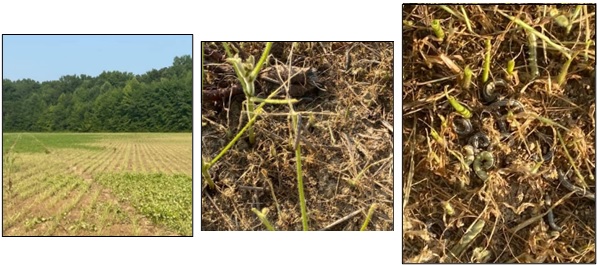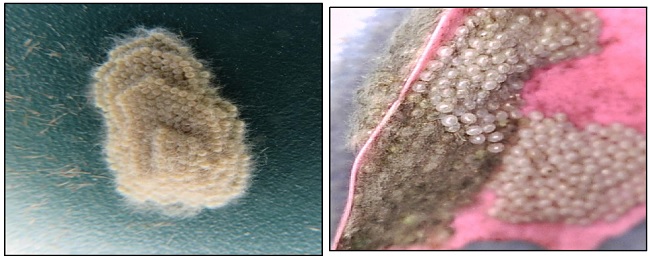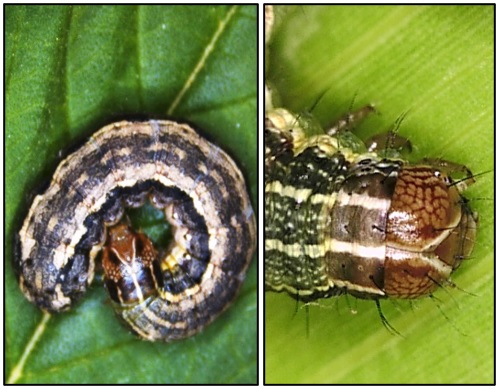Management of Fall Armyworms in Double Crop Soybeans in Kentucky
ENTFACT-161: Management of Fall Armyworms in Double Crop Soybeans in Kentucky | Download PDF
Raul T. Villanueva, Extension Specialist
The larval stage of the fall armyworm (FAW), Spodoptera frugiperda (Lepidoptera: Noctuidae), is a voracious defoliator of many plant species. Studies had shown that fall armyworm consists of two strains defined by host range and different molecular sequences in the DNA. The corn strain prefers corn, sorghum, whereas the rice strain has preference for grass forages, alfalfa, and rice. The fall armyworm is a native species to the Americas. In the continental USA, it overwinters in south Florida or in the southernmost region of Texas. The adults (Figure 1) are strong fliers and move northward during the summer months. In double-crop soybeans, fall armyworms can be devastating defoliators affecting small seedlings through V4 stages (Figure 2).
Figure 1. Female (F) and male (M) fall armyworms (Photos: University of Missouri) and two male FAW with folded wings (Photo: R. Villanueva, UK).
Fall armyworm usually reaches Kentucky by the end of June to beginning of July as they migrate to northern regions where they may occasionally develop into large populations during the fall and cause sporadic outbreaks. Their migratory path includes most states east of the Rocky Mountains and several provinces of Canada including Ontario, Quebec, and Nova Scotia. In 2016, 2018, and 2020, the fall armyworm was found in Africa, Asia, and Australia respectively. In these locations it became a well-established pest of many crops.
Biology
A female fall armyworm (Figure 1) lays 50 to 200 eggs per cluster, which are covered with scales. Egg clusters have been observed on leaves, wood poles, screens, or plastic field flags (Figure 3). A single female can produce up to 2,000 eggs during its life span. Larvae from this egg cluster hatches at the the same time (Figure 4), can move to the ground or ballooning hanging from a strain of silk. The fall armyworm has six larval instars that can be completed in 14 to 30 days, depending on the temperature. Fall armyworm resembles corn earworm and true armyworm; however, fall armyworm has has a relatively smooth body and a cream-colored Y mark on the head capsule between the eyes (Figure 5). Pupation occurs in the ground and adults can live up to 20 days.
Damage
Fall armyworm is not a major soybean pest in KY however, occasional fall armyworm outbreaks can take soybean growers by surprise when their plants are defoliated quickly.

Figure 2. Soybean field damaged by fall armyworms in July 2021: (Top) defoliation of large areas of a double-crop soybean field, (Middle) a close-up of a soybean plant without any leaves, and a large FAW on the tip of a plant, and (Bottom) small pieces of stems remains along with high larva density on the ground (Photos: Todd Elkins)
For example, in 2021, several counties of central and western Kentucky, from La Center (Ballard Co.) to Bowling Green (Warren Co.) reported severe damage in late June. Fall armyworm damage was reported for forages, sorghum, and soybeans. Although fall armyworm can attack corn, damages were not reported for this crop. The strain of fall armyworm that caused the 2021 outbreak was the rice strain. By the end of August, hay and forage fields were damaged in most counties of KY. In double crop soybeans, early fall armyworm larva instars skeletonize the lower leaves, this primary damage is usually undetectable. As larvae develop and move upward on the plant, feeding occurs over the whole plant canopy, then severe damage becomes visible. In most cases, severely damaged plants can have a ragged appearance without leaves or small sections of stems remain (Figure 2).
Management
Soybeans plants are strong and resilient and can tolerate nearly 100% foliage loss during the early vegetative stages before yield loss is achieved. The late vegetative stage of soybeans can also bear heavy fall armyworm feeding. However, if double-crop soybeans are affected in the early seedling stage by fall armyworm that consume the apical meristems, the damage is irreparable, and plant will not produce leaves or beans.
Pyrethroid insecticides are effective against fall armyworm using the highest labeled rates, but their efficacy declines for late larval instars. Early detection of infestations will allow for more effective control of this pest if larvae are larger than ¾ inch in length. Also, some insecticides with double mode of action are effective and may be used in case of low pyrethroid efficacy or major outbreaks.
For all these insecticides, the use of high volumes of water will generally result in better coverage, especially under adverse conditions (e.g., hot and dry days) or dense plant canopy. Migratory waves of fall armyworm usually can be present until the fall.
Figure 3. Egg clusters of fall armyworm: eggs are laid in layers and covered with scales (Photos: R. Villanueva, UK)
Figure 4. Recently emerged fall armyworm larvae; notice the black head capsule and when emerge they are aggregate near the egg cluster (Photo: Raul Villanueva, UK)
Insect Thresholds
In soybeans, a threshold for fall armyworm is not well established, as a precautionary action it would be necessary to spray using thresholds established for corn: if egg masses are present on 5% of the plants, or when 25% of plants are infested with larvae.
The thresholds used in North Carolina for defoliating insects in soybeans is 30% defoliation throughout the plant canopy 2 weeks prior to blooming (R1) and 15% defoliation throughout the plant canopy 2 weeks prior to flowering (stage varies) until the pods have filled (R7-R8).
Figure 5. A distinctive, light-colored inverted Y mark is present on the head capsule of fall armyworms and coloration changes of FAW larvae (Photo: Raul Villanueva, UK)
More Information:
- Fall Armyworm Moth Numbers Increasing (KPN 07/27/21)
- Armyworm Complex in Soybean (NCSU 04/07/2020)
- Fall Armyworm in Corn (KPN 2019)
- Watch for Fall Armyworm in Pastures (KPN 08/27/2019)
- Fall armyworm in Featured Creatures (University of Florida) (Last updated 2019)
Issued: 4/22
CAUTION! Pesticide recommendations in this publication are registered for use in Kentucky, USA ONLY! The use of some products may not be legal in your state or country. Please check with your local county agent or regulatory official before using any pesticide mentioned in this publication.
Of course, ALWAYS READ AND FOLLOW LABEL DIRECTIONS FOR SAFE USE OF ANY PESTICIDE!




